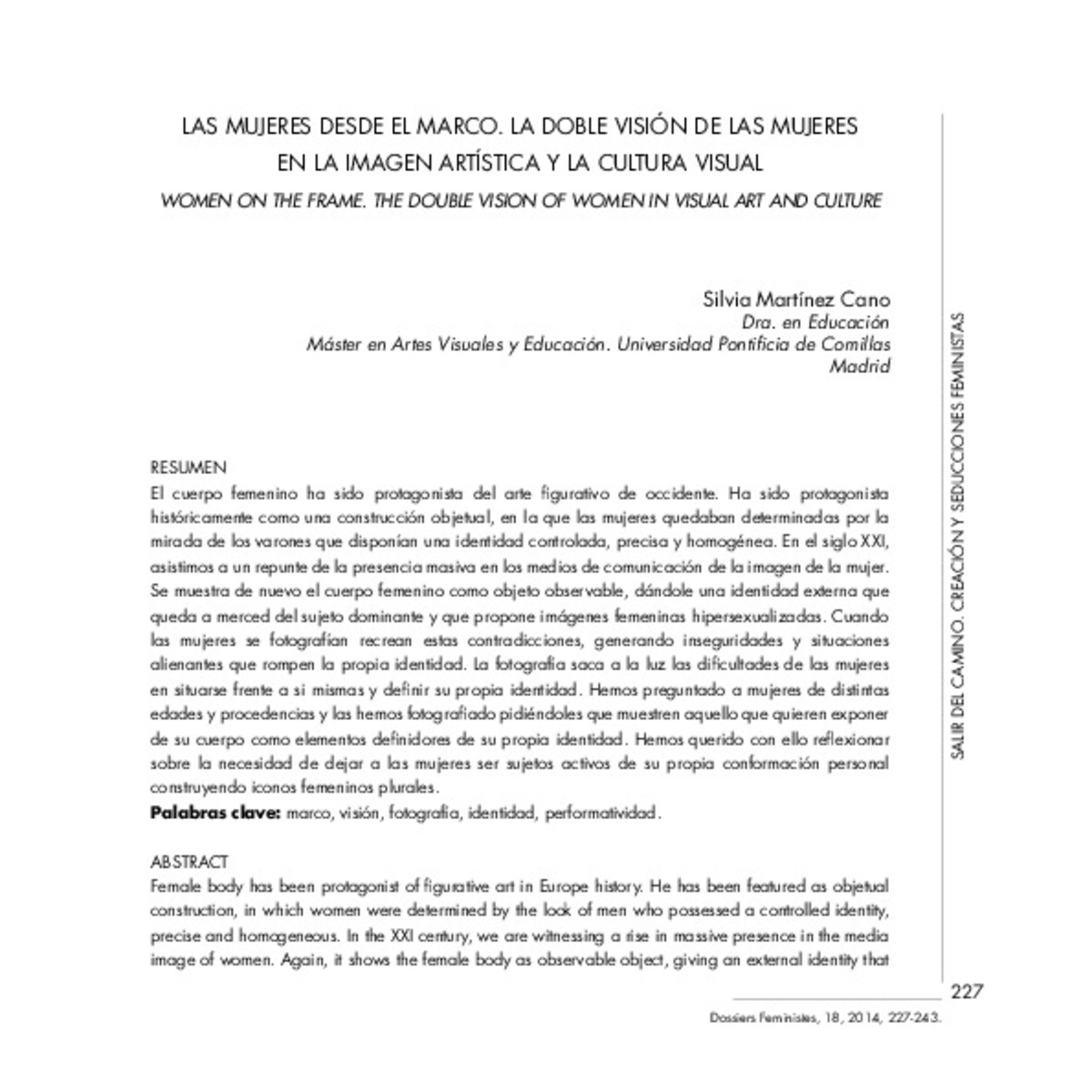Mostrar el registro sencillo del ítem
Las mujeres desde el marco. La doble visión de las mujeres en la imagen artística y la cultura visual
| dc.contributor.author | Martínez Cano, Silvia | |
| dc.coverage.temporal | 2014 | ca_CA |
| dc.date.accessioned | 2016-06-06T11:50:27Z | |
| dc.date.available | 2016-06-06T11:50:27Z | |
| dc.date.issued | 2014 | |
| dc.identifier.issn | 1139-1219 | |
| dc.identifier.issn | 2340-4930 | |
| dc.identifier.uri | http://hdl.handle.net/10234/160370 | |
| dc.description | Female body has been protagonist of figurative art in Europe history. He has been featured as objetual construction, in which women were determined by the look of men who possessed a controlled identity, precise and homogeneous. In the XXI century, we are witnessing a rise in massive presence in the media image of women. Again, it shows the female body as observable object, giving an external identity that is at the mercy of the dominant subject and proposed hypersexualized female images. When women are photographed recreate these contradictions, creating uncertainties and situations that break alienating identity. The photography exposes the difficulties of women stand in front of themselves and define their own identity. We asked women of different ages and backgrounds have photographed and asking them to show what they want to expose your body as defining elements of their own identity. We wanted it to reflect on the need to allow women to be active subjects of their own personal identity and to built female and plural icons. | ca_CA |
| dc.description.abstract | El cuerpo femenino ha sido protagonista del arte figurativo de occidente. Ha sido protagonista históricamente como una construcción objetual, en la que las mujeres quedaban determinadas por la mirada de los varones que disponían una identidad controlada, precisa y homogénea. En el siglo XXI, asistimos a un repunte de la presencia masiva en los medios de comunicación de la imagen de la mujer. Se muestra de nuevo el cuerpo femenino como objeto observable, dándole una identidad externa que queda a merced del sujeto dominante y que propone imágenes femeninas hipersexualizadas. Cuando las mujeres se fotografían recrean estas contradicciones, generando inseguridades y situaciones alienantes que rompen la propia identidad. La fotografía saca a la luz las dificultades de las mujeres en situarse frente a si mismas y definir su propia identidad. Hemos preguntado a mujeres de distintas edades y procedencias y las hemos fotografiado pidiéndoles que muestren aquello que quieren exponer de su cuerpo como elementos definidores de su propia identidad. Hemos querido con ello reflexionar sobre la necesidad de dejar a las mujeres ser sujetos activos de su propia conformación personal construyendo iconos femeninos plurales. | ca_CA |
| dc.format.extent | 17 p. | ca_CA |
| dc.format.mimetype | application/pdf | ca_CA |
| dc.language.iso | spa | ca_CA |
| dc.publisher | Universitat Jaume I. Institut Universitari d'Estudis Feministes i de Gènere | ca_CA |
| dc.relation.isPartOf | Dossiers Feministes, núm.18 | ca_CA |
| dc.rights.uri | http://rightsstatements.org/vocab/CNE/1.0/ | * |
| dc.subject | marco | ca_CA |
| dc.subject | visión | ca_CA |
| dc.subject | fotografía | ca_CA |
| dc.subject | identidad | ca_CA |
| dc.subject | performatividad | ca_CA |
| dc.subject | frame | ca_CA |
| dc.subject | vision | ca_CA |
| dc.subject | photography | ca_CA |
| dc.subject | identity | ca_CA |
| dc.subject | performativity | ca_CA |
| dc.subject.other | Dones -- Revistes | ca_CA |
| dc.subject.other | Feminisme -- Revistes | ca_CA |
| dc.title | Las mujeres desde el marco. La doble visión de las mujeres en la imagen artística y la cultura visual | ca_CA |
| dc.type | info:eu-repo/semantics/article | ca_CA |
| dc.rights.accessRights | info:eu-repo/semantics/openAccess | ca_CA |







